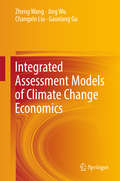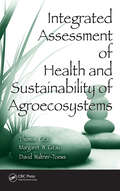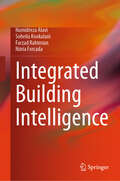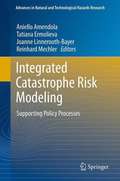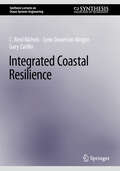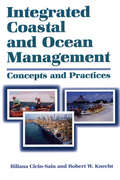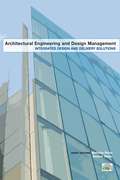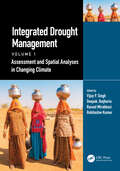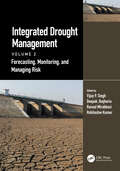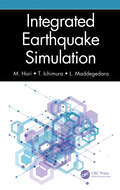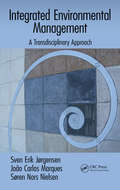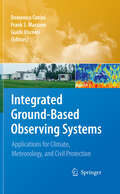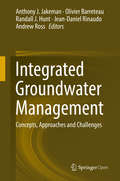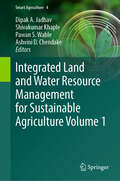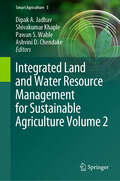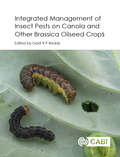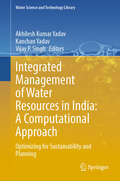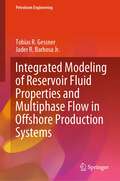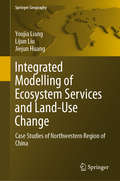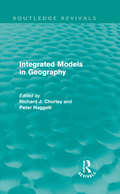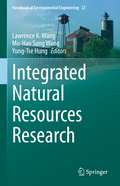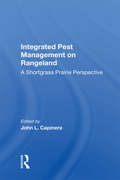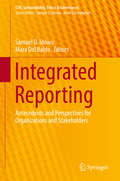- Table View
- List View
Integrated Assessment Models of Climate Change Economics
by Zheng Wang Jing Wu Changxin Liu Gaoxiang GuThis book describes the principles of integrated assessment models (IAM) for climate change economics and introduces various computable models for different development mechanisms under climate change governance. The authors present several new models they have constructed based on the RICE framework, specifically the MRICES((multi-factor RICE)) and EMRICES models, which incorporate global economic interactions into the RICE framework, and the CINCIA model, which describes technological advances and industrial structure evolution, introducing the mechanism of evolutionary economics. The models discussed in the book help governments and policy-makers tackle climate change and take positive measures on climate governance as well as promote economic and social development to narrow the gaps between countries.
Integrated Assessment of Health and Sustainability of Agroecosystems (Advances in Agroecology)
by David Waltner-Toews Thomas Gitau Margaret W. GitauExploring the implementation of participatory, multistakeholder, and transdisciplinary ecosystem health research, Integrated Assessment of Health and Sustainability of Agroecosystems combines the latest theories in complexity and management with practical tools and approaches for sustainable rural development research.Although the text foc
Integrated Building Intelligence
by Hamidreza Alavi Soheila Kookalani Farzad Rahimian Núria ForcadaThis book integrates of Building Information Modeling (BIM) and Decision Support Systems (DSS) in the field of building design, construction, and maintenance. The book explores how BIM and DSS technologies can be synergistically utilized to enhance performance, comfort, and maintenance efficiency in buildings. With an emphasis on practical applications, the book provides a comprehensive overview of the latest advancements in BIM and DSS, including real-world case studies and implementation guidelines. The book features illustrations, tables, and examples that aid in understanding complex concepts and demonstrate the practical application of BIM and DSS in building projects. Readers will gain a deep understanding of how BIM and DSS can be integrated to optimize building design, streamline construction processes, and improve facility management and maintenance. The main benefit of reading this book is that it provides a valuable resource for professionals in the architecture, engineering, and construction industries who want to leverage the power of BIM and DSS to enhance their building projects. Additionally, the book explores how BIM and DSS can contribute to energy efficiency.
Integrated Catastrophe Risk Modeling: Supporting Policy Processes
by Tatiana Ermolieva Aniello Amendola Reinhard Mechler Joanne Linnerooth-BayerEfficient and equitable policies for managing disaster risks and adapting to global environmental change are critically dependent on development of robust options supported by integrated modeling. The book is based on research and state-of-the art models developed at IIASA (International Institute for Applied Systems Analysis) and within its cooperation network. It addresses the methodological complexities of assessing disaster risks, which call for stochastic simulation, optimization methods and economic modeling. Furthermore, it describes policy frameworks for integrated disaster risk management, including stakeholder participation facilitated by user-interactive decision-support tools. Applications and results are presented for a number of case studies at different problem scales and in different socio-economic contexts, and their implications for loss sharing policies and economic development are discussed. Among others, the book presents studies for insurance policies for earthquakes in the Tuscany region in Italy and flood risk in the Tisza river basin in Hungary. Further, it investigates the economic impact of natural disasters on development and possible financial coping strategies; and applications are shown for selected South Asian countries. The book is addressed both to researchers and to organizations involved with catastrophe risk management and risk mitigation policies.
Integrated Catastrophe Risk Modeling: Supporting Policy Processes (Advances in Natural and Technological Hazards Research #32)
by Tatiana Ermolieva Aniello Amendola Reinhard Mechler Joanne Linnerooth-BayerEfficient and equitable policies for managing disaster risks and adapting to global environmental change are critically dependent on development of robust options supported by integrated modeling. The book is based on research and state-of-the art models developed at IIASA (International Institute for Applied Systems Analysis) and within its cooperation network. It addresses the methodological complexities of assessing disaster risks, which call for stochastic simulation, optimization methods and economic modeling. Furthermore, it describes policy frameworks for integrated disaster risk management, including stakeholder participation facilitated by user-interactive decision-support tools. Applications and results are presented for a number of case studies at different problem scales and in different socio-economic contexts, and their implications for loss sharing policies and economic development are discussed. Among others, the book presents studies for insurance policies for earthquakes in the Tuscany region in Italy and flood risk in the Tisza river basin in Hungary. Further, it investigates the economic impact of natural disasters on development and possible financial coping strategies; and applications are shown for selected South Asian countries. The book is addressed both to researchers and to organizations involved with catastrophe risk management and risk mitigation policies.
Integrated Coastal Resilience (Synthesis Lectures on Ocean Systems Engineering)
by C. Reid Nichols Lynn Donelson Wright Gary ZarilloThe potential for natural hazards and vulnerability to these threats varies from community to community. Adaptation will require ongoing monitoring of the natural and built-up environments and the development of policies, structures, and approaches to ensure resilient communities. Resilient approaches involve assessing risk and vulnerability, identifying solutions to reduce risks, implementing viable solutions, and assessment. Owing to past damages from extreme weather, countries around the world are making significant investments in coastal infrastructure that will reduce risks from disasters that are exacerbated by climatic changes.
Integrated Coastal and Ocean Management: Concepts And Practices
by Robert Knecht Biliana Cicin-Sain Gunnar KullenbergBiliana Cicin-Sain and Robert W. Knecht are co-directors of the Center for the Study of Marine Policy at the University of Delaware in Newark, Delaware and co-authors of The Future of U.S. Ocean Policy (Island Press, 1998).
Integrated Design and Delivery Solutions (Architectural Engineering and Design Management)
by Matthijs Prins Robert OwenIntegrated Design and Delivery Solutions (IDDS) represent a significant new research trajectory in the integration of architecture and construction through the rapid adoption of new processes. This book examines the ways in which collaboration and new methods of contracting and procurement enhance skills and improve processes in terms of lean and sustainable construction. Based on high quality research and practice-based examples that provide key insights into IDDS and its future potential, this book surveys the technologies that are being employed to create more sustainable buildings with added value for clients, stakeholders and society as whole.
Integrated Drought Management, Volume 1: Assessment and Spatial Analyses in Changing Climate (Drought and Water Crises)
by Vijay P. Singh, Deepak Jhajharia, Rasoul Mirabbasi and Rohitashw KumarThe first volume of this comprehensive global perspective on Integrated Drought Management is focused on understanding drought, causes, and the assessment of drought impacts. It explains different types of drought: agricultural, meteorological, hydrological, and socioeconomic droughts, their indices and the impact of climate change on drought. The volume also examines spatiotemporal analysis of drought, variability and patterns, assessment, and drought evaluation. With numerous case studies from India, Mexico, Turkey, Brazil, US, and other countries, this volume serves as a valuable resource for all readers who want to advance their knowledge on drought and risk management. Features: Provides a global perspective on drought prediction and management and a synthesis of the recent state of knowledge. Covers a wide range of topics from essential concepts and advanced techniques for forecasting and modeling drought to societal impacts, consequences, and planning. Presents numerous case studies with different management approaches from different regions and countries. Addresses how climate change impacts drought, the increasing challenges associated with managing drought, decision making, and policy implications. Includes contributions from hundreds of experts around the world. Professionals, researchers, academics, and postgraduate students with knowledge in environmental sciences, ecology, agriculture, forestry, hydrology, water resources engineering, and earth sciences, as well as those interested in how climate change impacts drought management, will gain new insights from the experts featured in this two-volume handbook.
Integrated Drought Management, Volume 2: Forecasting, Monitoring, and Managing Risk (Drought and Water Crises)
by Vijay P. Singh, Deepak Jhajharia, Rasoul Mirabbasi and Rohitashw KumarThe second volume of this comprehensive global perspective on Integrated Drought Management is focused on drought modeling, meteorological prediction, and the use of remote sensing in assessing, analyzing, and monitoring drought. It discusses risk management, planning, policy, and societal impacts of drought such as water pricing, water transfer, water quality, and crop insurance. Through numerous case studies from India, Iran, Brazil, the US, Nepal, and other countries that cover a broad range of topics and geographical regions, this volume serves as a valuable resource for all professionals, researchers, and academics who want to advance their knowledge about droughts. Features Provides a global perspective on drought prediction and management and a synthesis of the recent state of knowledge. Covers a wide range of topics from essential concepts and advanced techniques for forecasting and modeling drought to societal impacts, consequences, and planning Presents numerous case studies with different management approaches from different regions and countries. Addresses how climate change impacts drought, the increasing challenges associated with managing drought, decision-making, and policy implications. Includes contributions from hundreds of experts from around the world. Professionals, researchers, academics, and postgraduate students with knowledge in environmental sciences, ecology, agriculture, forestry, hydrology, water resources engineering, and earth sciences, as well as those interested in how climate change impacts drought management, will gain new insights from the experts featured in this two-volume handbook.
Integrated Earthquake Simulation
by M. Hori T. Ichimura L. MaddegedaraIntegrated earthquake simulation (IES) is a new method for evaluating earthquake hazards and disasters induced in cities and urban areas. It utilises a sequence of numerical simulations of such aspects as earthquake wave propagation, ground motion amplification, structural seismic response, and mass evacuation. This book covers the basics of numerical analysis methods of solving wave equations, analyzing structural responses, and developing agent models for mass evaluation, which are implemented in IES. IES makes use of Monte-Carlo simulation, which takes account of the effects of uncertainties related to earthquake scenarios and the modeling of structures both above and below ground, and facilitates a better estimate of overall earthquake and disaster hazard. It also presents the recent achievement of enhancing IES with high-performance computing capability that can make use of automated models which employ various numerical analysis methods. Detailed examples of IES for the Tokyo Metropolis Earthquake and the Nankai Trough Earthquake are given, which use large scale analysis models of actual cities and urban areas.
Integrated Environmental Management: A Transdisciplinary Approach (Applied Ecology and Environmental Management)
by Søren Nors Nielsen Sven Erik Jörgensen Joao Carlos MarquesBased on 40 years of experience, Integrated Environmental Management: A Transdisciplinary Approach brings together many ecological and technological tool boxes and applies them in a transdisciplinary method. The book demonstrates how to combine continuous improvement management tools and principles with proven environmental assessment methodologies
Integrated Flood Risk Management: Basic Concepts and the Japanese Experience
by Kuniyoshi TakeuchiThis book tackles the question of how we can manage flood-related disaster risks, such as from typhoons, monsoons, and torrential rain, which have been intensified by climate change and have generated unprecedented floods, landslides and debris flows worldwide. It presents recent conceptual developments in disasters, risk and resilience, and surveys UN policies on environment and development as well as disaster management. Sustainable and resilient development requires an integrated approach and human empowerment. Japan provides a useful example of effective flood management and disaster recovery in its current strategies for river and basin integrated flood management. Very few English-language books present up-to-date Japanese experiences for students and professionals in the context of global trends, relevant to a time of climate change and with global application. • Outlines an integrated approach to flood risk management in the context of UN initiatives • Details Japanese good practice developed through culture and the needs of a changing society Integrated Flood Risk Management is ideal for professionals working for environmental agencies, hydrologists and engineers, as well as students of disaster management and water resources development.
Integrated Ground-Based Observing Systems
by Domenico Cimini Frank S. Marzano Guido ViscontiThe book is a collection of the lectures delivered during the 7th International Summer School on Atmospheric and Oceanic Sciences (ISSAOS) titled "Integrated Ground-Based Observing Systems Applications for Climate, Meteorology, and Civil Protection". Its aim is to contribute to the scientific understanding of basic concepts and applications of integrated ground-based observing systems. The first part describes the most common instrumentations showing their strengths and limitations. Furthermore, strategic plans for the deployment of an observation site are discussed along with an overview of techniques for integrating heterogeneous data. The second part introduces cutting-edge applications, including assimilation in numerical weather prediction, climate benchmarking, air quality monitoring and meteo/hydrological warnings.
Integrated Groundwater Management
by Andrew Ross Olivier Barreteau Anthony J. Jakeman Randall J. Hunt Jean-Daniel RinaudoThe aim of this book is to document for the first time the dimensions and requirements of good integrated groundwater management. Groundwater management is a formidable challenge and should be one of humanity's foremost priorities. Given past and current rates of over-extraction, groundwater is largely a non-renewable resource in many parts of the world. The issue is how we manage this crucial resource in an acceptable way that considers the sustainability of the resource for future generations and the socioeconomic and environmental impacts. In many cases this means restoring a degree of equilibrium to at-risk aquifers. There are many, often-interrelated dimensions to managing groundwater effectively. It is important to get the science and social science right, to work on, and with, the policy framework, and to ensure the wider community, and stakeholders in areas of concern, support and participate in making the challenging decisions. Generally speaking, pursuing an integrated approach will mean considering the wider context of surface water and catchment management. Each chapter in this book makes a clear distinction between the methods currently practiced for groundwater management and those of IWRM. The book provides an overview of the dimensions and requirements of groundwater management from an international perspective, i. e. what practitioners and researchers need to bear in mind about groundwater management as the preservation of a shared global resource. The book is divided into five sections, each of which addresses concepts, approaches and difficulties in the application of methods for the management of groundwater. Section 1 highlights the scale of groundwater issues internationally: the level of exploitation and the resultant pressure quantitatively and qualitatively. Section 2 discusses groundwater governance issues with regard to strategies, policies and institutions for integrated water management, while Section 3 discusses biophysical aspects including the capacity and role of hydroecological and hydrogeological science and the need for ecological assessments. Section 4 particularly discusses water quality concerns and its management within the broader as well as within the social economic context. Lastly, Section 5 deals with the current state of modeling and decision-making support system and how to deal with data and uncertainty issues.
Integrated Land and Water Resource Management for Sustainable Agriculture Volume 1 (Smart Agriculture #4)
by Dipak A. Jadhav Shivakumar Khaple Pawan S. Wable Ashvini D. ChendakeThis book covers up-to-date research on various emerging technologies in agriculture and agricultural engineering with discussing the advancement and gap between different techniques. In this sense, this book features the application of the newly developed technologies for effective farm management and precise agriculture to improve the crop yield with maintaining the soil conditions. This book includes the application of allied engineering branches to agriculture including robotics, drone technology, remote sensing & GIS, computational modeling, ICT tools, sensing techniques, agricultural mechatronics, nano-biotechnology applied mechanics, etc. Any upcoming early stage researchers and scientist working in this research domain get idea and knowledge about various aspects and dimensions of water resource engineering advancement and give directions to solve real field challenges for sustaining in future water demand.
Integrated Land and Water Resource Management for Sustainable Agriculture Volume 2 (Smart Agriculture #5)
by Dipak A. Jadhav Shivakumar Khaple Pawan S. Wable Ashvini D. ChendakeThis book covers up-to-date research on various emerging technologies in agriculture and agricultural engineering with discussing the advancement and gap between different techniques. In this sense, this book features the application of the newly developed technologies for effective farm management and precise agriculture to improve the crop yield with maintaining the soil conditions. This book includes the application of allied engineering branches to agriculture including robotics, drone technology, remote sensing & GIS, computational modeling, ICT tools, sensing techniques, agricultural mechatronics, nano-biotechnology and applied mechanics, etc. Any upcoming early stage researchers and scientist working in this research domain get idea and knowledge about various aspects and dimensions of water resource engineering advancement and give directions to solve real field challenges for sustaining in future water demand.
Integrated Management of Insect Pests on Canola and Other Brassica Oilseed Crops
by Gadi V.P. ReddyThis book comprehensively reviews current pest management practices and explores novel integrated pest management strategies in Brassica oilseed crops. It is essential reading for pest management practitioners and researchers working on pest management in canola and other Brassica crops worldwide. Canola, mustard, camelina and crambe are the most important oilseed crops in the world. Canola is the second largest oilseed crop in the world providing 13% of the world's supply. Seeds of these species commonly contain 40% or more oil and produce meals with 35 to 40% protein. However, its production has declined significantly in recent years due to insect pest problems. The canola pest complexes are responsible for high insecticide applications on canola. Many growers rely on calendar-based spraying schedules for insecticide applications. The diamondback moth Plutella xylostella and flea beetles Phyllotreta spp. (P. cruciferae and P. striolata)cause serious damage to canola. In the Northern Great Plains, USA, for instance, P. xylostella is now recorded everywhere that canola is grown. Severe damage to canola plants can be caused by overwintering populations of flea beetles feeding on newly emerged seedlings. Cabbage seed pod weevil (Ceutorhynchus obstrictus), swede midge (Contarinia nasturtii), and tarnished plant bug (Lygus lineolaris) are also severe pests on canola. Minor pests include aphids (cabbage aphid, Brevicoryne brassicae and turnip aphid, Hyadaphis erysimi) and grasshopper, Melanoplus sanguinipes. This book: #65533; is the only single compiled source of information on integrated management of canola and other Brassica oilseed pests #65533; presents the biology and management of all the major and minor pests of Brassica oilseed crops #65533; is an essential source of information for applied entomologists, crop protection researchers, extension agents and stakeholders
Integrated Management of Water Resources in India: Optimizing for Sustainability and Planning (Water Science and Technology Library #129)
by Vijay P. Singh Akhilesh Kumar Yadav Kanchan YadavThis book tackles the complexities of water management in India. Using computational tools, it provides comprehensive information on water availability, demand, climate change, integrated management, and governance. A must-read for researchers, policymakers, and water managers. The book is structured to provide a holistic understanding of water resources in India and the need for an integrated approach to their management. It explores various aspects of water management, including data collection and analysis, water allocation and planning, water quality management, and the intricate interdependencies within the water-energy-food nexus. One of the key focuses of this book is the application of computational approaches in the management of water resources. We explore the use of advanced modeling, simulation, and optimization techniques to facilitate decision making, assess water availability, and predict future scenarios. By employing computational tools, our goal is to bridge the gap between theoretical concepts and practical implementation, empowering water managers, policymakers, researchers, and other stakeholders to make informed and effective decisions. Throughout the book, we present case studies highlighting the application of computational approaches in diverse water management scenarios in India. These case studies offer valuable information on real-world challenges and demonstrate the potential of computational techniques to address complex water resources problems. We also explore the importance of stakeholder engagement, participatory approaches, and collaborative governance models, recognizing the importance of inclusive decision-making processes and local knowledge in achieving sustainable water management. The book is expected to serve as a valuable resource for students, researchers, professionals, and policymakers involved in water resource management in India. We aim to contribute to the ongoing efforts to ensure the availability of clean and adequate water resources for present and future generations.
Integrated Modeling of Reservoir Fluid Properties and Multiphase Flow in Offshore Production Systems (Petroleum Engineering)
by Tobias R. Gessner Jader R. Barbosa Jr.The book is intended for practicing engineers in the oil industry, researchers, and graduate students interested in designing and simulating offshore hydrocarbon production systems. It approaches offshore oil production systems from an integrated perspective that combines the modeling of thermophysical properties of reservoir fluids and their flow as a multiphase mixture in wellbores, flow lines, and risers.The first part of the book presents an internally consistent method to compute the critical parameters and acentric factor of Single Carbon Number (SCN) fractions of petroleum mixtures using state-of-the-art multivariate fitting techniques. The procedure is illustrated and validated using flash and differential liberation data from actual field samples. In the second part of the book, mechanistic multiphase flow models are discussed in light of their ability to predict the pressure, temperature, and phase holdup of production fluids in wellbores, flow lines, and risers. Multivariate fitting procedures are again applied to evaluate the sensitivity of the results with respect to closure relationship parameters, such as slug body gas holdup, wall shear stress, and wall roughness in pipelines and production tubing. Finally, the modeling framework is validated using actual field data from offshore production wells.
Integrated Modelling of Ecosystem Services and Land-Use Change: Case Studies of Northwestern Region of China (Springer Geography)
by Youjia Liang Lijun Liu Jiejun HuangThis book presents essential case studies on the integrated modelling of ecosystem services and land-use change in the field of landscape ecology. The case studies were mainly conducted in the Zhangye oasis of the Hexi corridor and the upper reaches of the Heihe river basin, including Loess plateau (for wind power) and the inland waterways of the Yangtze River (for the regulation of extreme events). The book puts forward an integrated modelling method, including human activities, natural processes, land-use change, and ecosystem management, and explores multiple scenarios based on the interests of local managers and their implications for ecosystem services. As the book demonstrates, the integrated modelling method for ecosystem services and land-use change can serve as a valuable tool for gauging the impact of various development scenarios in this study area, and in other regions with similar characteristics. In addition, numerous charts and diagrams are included in each chapter, facilitating the simulation and assessment of specific land-use change impacts on ecosystem services in various study areas.
Integrated Models in Geography (Routledge Revivals)
by Richard J. Chorley Peter HaggettFirst published in 1967, this book explores the theme of geographical generalization, or model building. It is composed of five of the chapters from the original Models in Geography, published in 1967. The first chapter broadly outlines this theme and examines the nature and function of generalized statements, ranging from conceptual models to scale models, in a geographical context. The following chapters deal with mixed-system model building in geography, wherein data, techniques and concepts in both physical and human geography are integrated. The book contains chapters on organisms and ecosystems as geographical models as well as spatial patterns in human geography. This text represents a robustly anti-idiographic statement of modern work in one of the major branches of geography.
Integrated Natural Resources Research (Handbook of Environmental Engineering #22)
by Lawrence K. Wang Yung-Tse Hung Mu-Hao Sung WangThis book is a sister volume to Volume 20 of the Handbook of Environmental Engineering Series, "Integrated Natural Resources Management", and expands on the themes of that volume by addressing the conservation and protection of natural resources in an environmental engineering context through state-of-the-art research methodologies and technologies. With a focus on water and wastewater treatment, the book takes a multidisciplinary approach to provide readers with an understanding of developments in natural resources technology over the last few decades, and how technology and industry methods will progress to ensure cleaner and sustainable methods of natural resources management. The key topics covered include biological activated carbon treatment for recycling biotreated wastewater, composting for food processing wastes, treatment of wastewater from chemical industries, agricultural waste as a low-cost adsorbent, and the invention, design and construction of potable water dissolved air flotation and filtration plants. The book will be useful to environmental resources engineers, researchers, water treatment plant managers, chemical engineers, industrial plant managers, and environmental conservation agencies.
Integrated Pest Management On Rangeland: A Shortgrass Prairie Perspective
by John L. CapineraGrasslands comprise the largest and most diverse set of ecosystems in the United States and are among the most extensive in the world. Characterized by scanty rainfall, these western grasslands are too dry for crop production and are used almost exclusively for grazing livestock. The grasslands on the western edge of the Great Plains, known as the
Integrated Reporting: Antecedents and Perspectives for Organizations and Stakeholders (CSR, Sustainability, Ethics & Governance)
by Samuel O. Idowu Mara Del BaldoThis book critically examines the implementation and adoption of integrated reporting (IR) in organizations and corporations. A relatively new area of policy and practice, IR has rapidly gained considerable prominence since the formation of the International Integrated Reporting Committee in 2010. The book analyzes the outcomes and benefits as well as the shortfalls of integrated reporting. It offers an introduction to the foundations of IR and a comprehensive overview of its use through a number of detailed case studies. Lastly, it discusses the outlook for further developments in sustainability accounting and reporting.
